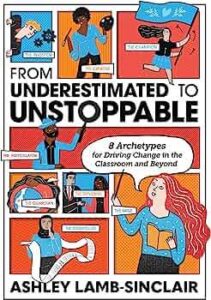Archetypes for Driving Change in the Classroom
From Underestimated to Unstoppable: 8 Archetypes for Driving Change in the Classroom and Beyond
By Ashley Lamb-Sinclair
(ASCD, 2022 – Learn more)
Reviewed by Megan Balduf

It’s been a combination of my extensive experiences, being in the right place at the right time, knowing people who, as Lin Manuel Miranda put it, are “in the room where it happens.”
That’s what drew me to Ashley Lamb-Sinclair’s From Underestimated to Unstoppable. In the last few years, I’ve tried to manufacture situations where I can generate change more purposefully. As the author notes, “If you aren’t the one to create the change you hope to see, then who is?” (10).
Going beyond the usual personality test

While that wasn’t in the book, the text offers a number of similar items: archetype descriptions with a Likert scale, scenarios with archetype responses, archetypes sorted by shared characteristics. Additionally, Lamb-Sinclair channels Walt Whitman in acknowledging we all have some aspect of all the archetypes.
While one measure identified me as The Diplomat and another as The Storyteller, the piece that really helped me was Lamb-Sinclair’s in-depth exploration of each archetype. She spends the majority of the book providing explanations of what each archetype looks like and showcasing successful examples.
More clarity for the change-maker
Not only are the in-depth looks at each archetype helpful in recognizing oneself, seeing the different ways people can tap into their strengths to encourage change can make doing so less intimidating. I see this text as beneficial particularly to those whose path to change is not clear – those teachers and school leaders who know things can be better but aren’t sure what to do first.
The in-depth explanations Lamb-Sinclair provides include examples of how each archetype leads, the kinds of people they should look to for support, and what types of challenges they can expect to encounter. The beauty of these is their adaptability.
For example, one of my archetypes “leads through passionate defense of a cause” (36): this can work in any venue! One doesn’t need to be in the classroom or even a school system to see themselves in this kind of description. Being aware at the start of who to turn to and what obstacles (in the form of kinds of people, behaviors, or even structural roadblocks) may be in the way can save a change-maker valuable time and energy.
Actualizing your archetype
Throughout the text, Lamb-Sinclair asks readers to consider themselves as characters in the story of the change they want to make, so it only seems appropriate that her book finishes with chapters about your story’s plot (moving forward), setting (positioning yourself), and conflict or plot twists. These chapters dovetail with the next steps you can take once you’ve identified your archetype.
For plot, Lamb-Sinclair suggests tapping into what drives you and identifying what you want to do and what you hope to gain. Knowing these things can help you chart your course through your change story.
With setting, Lamb-Sinclair mentions two venues in which change-makers can operate: leverage and influence. Leverage points are those spaces where “opportunities lie to achieve a result,” (102) such as acquiring funding, piloting a program, and providing support for new adopters.
Lamb-Sinclair makes the point that, when it comes to change, influence is not the same as power or authority; it is an “indirect and often invisible” (114) guidance built into our relationships with others. Lamb-Sinclair suggests using our influence at those leverage points we feel comfortable with. So, for example, if you are a strong writer, offering to write the grant for program funding allows you to have influence over which grants are pursued.
Preparing for conflict
There is an entire chapter on responding to conflict, what kind of conflict you may encounter, and how to support yourself as you make your way through it. An overall strength of the text is the use of figures to illustrate concepts, and the chapter on conflict is where those figures shine. Each kind of conflict and support is explained and laid out in a quickly digestible, easy-to-understand figure.
If you’re in the middle of conflict and about to be derailed, the figures would provide a way to bounce back with (hopefully) minimal interruption to your change-making. Additionally, Lamb-Sinclair tackles what to do when you have a “plot twist” by laying out both “big-picture and right-now actions you plan to take” (121).
As you make your way through her text and are ready to tackle changes you wish to see, Lamb-Sinclair provides a step-by-step guide for “starting your change story right now” (124), including a series of prompts to help you determine what you want the outcome to be, how you’ll use leverage points effectively, who your stakeholders are (and what they’ll need to get on board), and how you’ll react to obstacles you’ll face.
Taking the time to consider all these issues upfront is intended to help smooth your path to the changes you’ll make. By helping you tap into your archetype, Ashley Lamb-Sinclair’s text helps set you up to make real changes in the lives around you.
Megan Balduf (@MBalduf) is a middle school English teacher with nineteen years’ experience. Being a classroom teacher was always her dream, and her experience allowed Megan to become a teacher leader, including being part of AMLE’s Teacher Leader Constituent Committee. Since entering the classroom, Megan has earned an MA in Gifted Education, an MA in English for Language Arts Teachers, and became a National Board Certified Teacher.




































